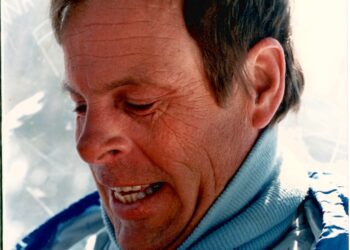By Denise Hoepfner MSU News Service
BOZEMAN – A Montana State University doctoral student who is seeking a cure for her son’s rare genetic disorder has won a fellowship that will allow her to quit the predawn paper route she took to make ends meet and concentrate fully on her research.
Elizabeth “Tess” Corbin, a doctoral student from Bozeman in the Department of Chemistry and Biochemistry, has won a Ford Foundation Dissertation Fellowship that will give her $25,000 over the next nine months and connect her with a network of other Ford Fellows and mentors. Corbin is one of 38 recipients of the fellowship, which supports the final year of dissertation writing and defense for individuals working toward a doctorate in science or philosophy.
Corbin said the fellowship came at a time when she didn’t think she would be able to swing the money needed to complete her dissertation. The award, in addition to a tuition waiver from the MSU Graduate School, has also made it possible for her to quit the paper route that provided some financial relief but left her exhausted by midday.
“Getting up at four in the morning, six days a week, was hard, but I did it gratefully knowing it was what I had to do,” said the single mother of two boys, ages 17 and 13. “But, to write and defend my dissertation I need to be able to focus.”
Corbin earned her bachelor’s degree in chemistry from MSU in 2009, but because her older son, Sean, has a rare genetic disorder called homocystinuria, she decided to pursue her doctorate in biochemistry and delve into stem cell research, despite having little academic background in either.
Homocystinuria affects one in 335,000 people, and is so rare because each parent has to carry the genetic mutation for it to occur, according to the National Institutes of Health. People with the disorder are unable to properly process methionine, one of 20 essential amino acids—the small molecules that make up proteins—which leads to build up of toxic products in the body and causes serious health problems.
Since his diagnosis, Sean has had several major surgeries, including brain surgery to stop seizures and lens replacement on his eyes to correct his blindness. And, he needs another surgery soon.
Not finding any effective treatments for the disorder because of its rarity, Corbin decided to work on the problem herself after she determined stem cell research was the most promising avenue to a cure.
“I went back to school and I’ve concentrated on this because of Sean’s problem,” she said. “There wasn’t any help for it, so what’s a mom to do?”
Corbin conducts her research under the guidance of Edward Dratz, professor of biochemistry. In the Dratz Lab, she is working to produce fatty acid supplements that can be added to the media that is used to grow stem cells. She hopes to develop two supplements—one for stem cell maintenance and another that can be used to aid in reprogramming the stem cells.
The goal, Corbin said, is to make stem cells a more reliable testing agent for research, which could potentially lead to a cure for homocystinuria and other enzyme disorders by way of taking a person’s own stem cells and genetically correcting them to produce the right enzymes.
“Personalized medicine is the future, and induced stem cell production and culture is the bedrock it is going to stand on,” Corbin said. “This is right round the corner—being able to take a person’s blood and reprogram their own blood cells into stem cells so there won’t be any allergy issues and they won’t be rejected. They can then be genetically corrected to produce the correct enzyme and be reintroduced into the body. If you can do that a couple of times on somebody, it’s personalized medicine.”
Corbin has worked on this project for the past six years—the first two were spent on coursework—but it wasn’t until the arrival of Renee Reijo Pera, MSU Vice President of Research and Economic Development, that Corbin made significant strides.
An internationally recognized stem cell scientist, Reijo Pera, along with geneticists Ninuo Xia and Benjamin Angulo, both researchers in Reijo Pera’s lab, were able to teach Corbin the molecular biology techniques she needed for her research so she could concentrate on her hypotheses and experiments.
“For a while there, I didn’t even know what questions to ask, so I was making some errors and really struggling before they came along,” Corbin said. “Since then, I’ve moved forward and we have gotten some results with adding my fatty acids to stem cells.”
The next step, she said, is to quantify those results through cell counts, which is difficult because stem cells tend to clump and colonize making them hard to count without killing them.
“They are experts,” Corbin said of Reijo Pera, Xia and Angulo. “They’re helping me get those processes down and we’ll get there.”
“It has been an honor for us to have a role in development of Tess’s research project,” said Reijo Pera. “She is very determined to make a difference via science.”
Corbin’s journey into the world of biochemistry came in a roundabout way. While studying finance and opera at the University of Washington, she experienced some life-altering personal setbacks and left school. She then spent many years in the music business, playing in a band, belting out Pat Benatar songs as a professional karaoke singer, and running various businesses.
She was 41 and newly divorced with a young son when she moved back to Bozeman and enrolled at MSU to complete her finance degree. Needing a physical science course to graduate, she signed up for chemistry.
“I got an A-plus and fell in love with chemistry, so instead of finishing up, I changed my major,” she said, not realizing the impact this choice would have on her and her son’s life.
It was during the time Corbin was working in MSU Associate Professor Robert Szilagyi’s physical chemistry lab that Sean began having seizures that doctors couldn’t explain. Szilagyi noticed Corbin crying in the lab one day and asked her what was wrong. After she told him about the many brain scans and tests Sean had been through with no answers, Szilagyi referred her to an imaging center that performs magnetic resonance imaging at double the strength of a regular MRI and at 200 times the resolution.
When the scan revealed three potential areas of the brain that could be causing her son’s problems, Corbin turned to the University of California, San Francisco to perform the brain surgery that stopped his seizures.
“If I hadn’t been in Dr. Szilagyi’s lab when Sean was having problems, I believe he would be dead today,” Corbin said.
As she spends the next nine months on her dissertation, Corbin is hopeful that her work will help to create better, more viable stem cells that can be used to develop therapies and cures for people who, like Sean, suffer from devastating disorders.
“I think that in the future I could be a part of making that happen and when the therapies are ready, I’ll know,” she said.














